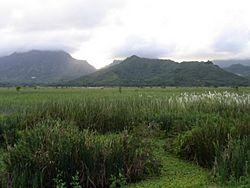Kawai Nui Marsh facts for kids
Quick facts for kids
Designations
|
|
| Official name: Kawainui and Hamakua Marsh Complex | |
| Designated: | 2 February 2005 |
|---|---|
| Reference #: | 1460 |
Kawainui Marsh, also known as Kawainui Fishpond, is the largest wetland in the Hawaiian Islands. It covers more than 800 acres (about 3.2 square kilometers). This important marsh is located in Kailua on the island of O'ahu.
The State of Hawaii and the City & County of Honolulu own the marsh. About 250 acres (1 square kilometer) were bought by the City and County of Honolulu in 1968. Kawainui Marsh became a special Ramsar Convention wetland site in February 2005. It is also the biggest former fishpond in all of Hawaii.
Contents
Amazing Wildlife at Kawainui
Kawainui Marsh is a home for many animals and plants found only in Hawaiʻi. This includes several species that are in danger of disappearing forever. Even though some non-native plants have grown here, Kawainui is still a vital place for many native Hawaiian water birds.
Some of these special birds include the Ae’o (Hawaiian Stilt), Alae Ula (Hawaiian Gallinule), Alae Keo keo (Hawaiian Coot), and Koloa (Hawaiian Duck). Protecting this marsh helps these unique birds survive.
A Look Back: Kawainui's History
The name Kawainui means "the big water" in the Hawaiian language. This name shows that the area was once a huge body of water connected to the ocean. This was true when the first Polynesians settled here. Kailua, where Kawainui is located, is one of the earliest places where people lived in Hawaiʻi.
For most of its history, Kawainui was used as a fishpond. Hawaiians used it to grow food through aquaculture, which is like farming in water. They raised different kinds of fish and also grew limu (seaweed). Kawainui is also famous in Hawaiian history for having a special kind of edible mud called lepo ʻai.
The marsh was surrounded by many taro farms. Taro is a plant grown in wet areas for its starchy root. Kawainui was also very important because several heiau, or Hawaiian temples, were built along its edges. The most famous ones are Ulupo Heiau on the east side and Pahukini Heiau and Holomakani Heiau on the west side. Hawaiian historians say that Kawainui used to be deep enough for European ships to sail into it directly from the ocean.
After the Great Mahele, which was a big land division in Hawaii, Queen Kalama became the owner of the Kailua area, including Kawainui. At this time, Chinese farmers mainly used the area for growing rice. Even as late as 1872, Princess Pauahi and Princess Likelike visited the area and ate the famous edible mud. This shows that the fishpond was still being cared for to produce this mud.
Kawainui Today
Today, most of Kawainui Marsh is covered by plants. These plants either float on the water or grow on a thick mat of peat (decayed plant material) that floats on the water. In the higher parts of the marsh, there is a wet meadow. This meadow is used by cattle for grazing when it's not flooded.
Most of the marsh is protected by a levee, which is a wall built to control floods. The United States Army Corps of Engineers built this levee. They are also in charge of moving water away from Kawainui and its streams. The marsh receives a lot of heavy rainfall from the nearby Maunawili Valley. The water from the marsh flows out through a man-made channel called Oneawa Channel.
Over the years, there have been attempts by the state government and private groups to build on Kawainui. However, local community groups, like the Lani-Kailua Outdoor Circle, have worked hard to stop further development. Their efforts have helped protect this important natural area.
Images for kids





